#User-Defined Type
Explore tagged Tumblr posts
Text



indeed my exact process once every 8 months or so
#I just thought today of a new way to format a 'profile' (like the descriptions of self that people use on friend meeting#apps and stuff) and how to organize the sections so that it seems such and such a way and oh what if there's links which click off#into branching paths so it's very acessible and there are two different forms depending on so on and so forth#and i was like 'um.. wow. amazing idea. this will be soooo aweseome and will definitely work' but then .. you know...self reflection#lol.. is this just like the millions of other iterations of a similar thing? No.. This Is Different ... Surely...#Though if I had a millionaire friend and a few people who do the type of coding you use for web design stuff and etc..#I could create the most elaborate detailed and amazing platonic friend seeking (and I guess you could also have 'dating' as an option#since that would draw in more of a crowd) website on the earth.. the new okcupid (back when okcupid didn't suckishly abandon their#whole format in hopes of trying to become just like tinder or whatever and they actually had like tons of info and percentages and#open answer questions and would list personality traits on a profile (like 'this person is more Open To New Expereinces than 65% of#other users' etc.). etc. etc. Oh what a beautiful thing I could craft for the detail freaks of the world.... Alas...#unfortunately we seem to be in an oversimplification era.. everything in short quick bites. everything on a tiny phone screen. etc.#marketing 'Introducing The Most Complicated Data Heavy Social Connection Site In The World' would not sell well I'd imagine gjhgjh#AANYWAY.. also no idea why the representation of me is in a turtle neck. what a bold fashion choice..#In another moment of self reflection.. the fact that in the first tag on this post I felt the need to define the word 'profile' just to be#specific as if people couldn't tell from context.. so clearly someone who finds filling out forms a 'fun afternoon activity' lol#the type of guy who finds psych evaluations and pop quizzes and making chore lists mostly enjoyable (< true)
48 notes
·
View notes
Text
Anyway needless to say, college is showing me a whole slew of people who are using laptops in school for the first time and they're so bad at it. They're so bad at taking notes too. They're so bad at everything
#im a hater today but its helping. ill get a caramel shortcake and thatll help more#ANYWAY STOP TAKING DOWN THE TEXT ON THE POWERPOINTS VERBATIM!!!!!!!!#THEYRE UP ON CANVAS PAY ATTENTION TO THE LECTURER INSTEAD!!!#(im haterposting instead of listening but im keeping an ear out. theyre defining bildungsromans rn)#their typing speeds are so slow and for most i would assume its inexperience#in which case i ask why are you switching to a laptop instead of using a notebook!!!!!#plus they mistreat their laptops so badly. so full of bloatware. some of them are even mac users#(honestly idk that much abt macs specifically. maybe theyre gr8. but i hate and kill apple)#give your laptops to me ill treat them right.... ill feed them ill clean up after them....#and you just know that tech disasters are gonna befall so many of them bcos tech skills are on a downslope#like i dont look it bcos i tote around the same 2 notebooks and take like 3 bullet points max of notes per lecture#but ive been using a laptop for school going on 7 years i know my shit!!!#and theyre heavy to carry around and generally only worth it if you plan on doing a LOT of typing#which for ordinary lectures im not!!!! im not taking down every word on the powerpoint like a dipshit!!!#if i bring my laptop im either planning on writing some essay shit or not paying attention during class#anyway thats my little rant. its alright im allowed
12 notes
·
View notes
Text
youtube
C++ User-defined Data Types in Hindi | Struct Data Type in C++ | Union Data Type | C++ Tutorials
In C++, user-defined data types are types that are defined by the programmer, allowing them to create custom data structures. These types are defined using the class, struct, union, or enum keywords in C++. These types are essential for creating more complex and flexible programs that go beyond the built-in data types. For more Details, Kindly check my website URL. https://www.removeload.com/cpp-data-types
0 notes
Text
CoPilot in MS Word
I opened Word yesterday to discover that it now contains CoPilot. It follows you as you type and if you have a personal Microsoft 365 account, you can't turn it off. You will be given 60 AI credits per month and you can't opt out of it.
The only way to banish it is to revert to an earlier version of Office. There is lot of conflicting information and overly complex guides out there, so I thought I'd share the simplest way I found.
How to revert back to an old version of Office that does not have CoPilot
This is fairly simple, thankfully, presuming everything is in the default locations. If not you'll need to adjust the below for where you have things saved.
Click the Windows Button and S to bring up the search box, then type cmd. It will bring up the command prompt as an option. Run it as an administrator.
Paste this into the box at the cursor: cd "\Program Files\Common Files\microsoft shared\ClickToRun"
Hit Enter
Then paste this into the box at the cursor: officec2rclient.exe /update user updatetoversion=16.0.17726.20160
Hit enter and wait while it downloads and installs.
VERY IMPORTANT. Once it's done, open Word, go to File, Account (bottom left), and you'll see a box on the right that says Microsoft 365 updates. Click the box and change the drop down to Disable Updates.
This will roll you back to build 17726.20160, from July 2024, which does not have CoPilot, and prevent it from being installed.
If you want a different build, you can see them all listed here. You will need to change the 17726.20160 at step 4 to whatever build number you want.
This is not a perfect fix, because while it removes CoPilot, it also stops you receiving security updates and bug fixes.
Switching from Office to LibreOffice
At this point, I'm giving up on Microsoft Office/Word. After trying a few different options, I've switched to LibreOffice.
You can download it here for free: https://www.libreoffice.org/
If you like the look of Word, these tutorials show you how to get that look:
www.howtogeek.com/788591/how-to-make-libreoffice-look-like-microsoft-office/
www.debugpoint.com/libreoffice-like-microsoft-office/
If you've been using Word for awhile, chances are you have a significant custom dictionary. You can add it to LibreOffice following these steps.
First, get your dictionary from Microsoft
Go to Manage your Microsoft 365 account: account.microsoft.com.
One you're logged in, scroll down to Privacy, click it and go to the Privacy dashboard.
Scroll down to Spelling and Text. Click into it and scroll past all the words to download your custom dictionary. It will save it as a CSV file.
Open the file you just downloaded and copy the words.
Open Notepad and paste in the words. Save it as a text file and give it a meaningful name (I went with FromWord).
Next, add it to LibreOffice
Open LibreOffice.
Go to Tools in the menu bar, then Options. It will open a new window.
Find Languages and Locales in the left menu, click it, then click on Writing aids.
You'll see User-defined dictionaries. Click New to the right of the box and give it a meaningful name (mine is FromWord).
Hit Apply, then Okay, then exit LibreOffice.
Open Windows Explorer and go to C:\Users\[YourUserName]\AppData\Roaming\LibreOffice\4\user\wordbook and you will see the new dictionary you created. (If you can't see the AppData folder, you will need to show hidden files by ticking the box in the View menu.)
Open it in Notepad by right clicking and choosing 'open with', then pick Notepad from the options.
Open the text file you created at step 5 in 'get your dictionary from Microsoft', copy the words and paste them into your new custom dictionary UNDER the dotted line.
Save and close.
Reopen LibreOffice. Go to Tools, Options, Languages and Locales, Writing aids and make sure the box next to the new dictionary is ticked.
If you use LIbreOffice on multiple machines, you'll need to do this for each machine.
Please note: this worked for me. If it doesn't work for you, check you've followed each step correctly, and try restarting your computer. If it still doesn't work, I can't provide tech support (sorry).
#fuck AI#fuck copilot#fuck Microsoft#Word#Microsoft Word#Libre Office#LibreOffice#fanfic#fic#enshittification#AI#copilot#microsoft copilot#writing#yesterday was a very frustrating day
3K notes
·
View notes
Note
How do you *accidentally* make a programming language?
Oh, it's easy! You make a randomizer for a game, because you're doing any% development, you set up the seed file format such that each line of the file defines an event listener for a value change of an uberstate (which is an entry of the game's built-in serialization system for arbitrary data that should persiste when saved).
You do this because it's a fast hack that lets you trigger pickup grants on item finds, since each item find always will correspond with an uberstate change. This works great! You smile happily and move on.
There's a small but dedicated subgroup of users who like using your randomizer as a canvas! They make what are called "plandomizer seeds" ("plandos" for short), which are seed files that have been hand-written specifically to give anyone playing them a specific curated set of experiences, instead of something random. These have a long history in your community, in part because you threw them a few bones when developing your last randomizer, and they are eager to see what they can do in this brave new world.
A thing they pick up on quickly is that there are uberstates for lots more things than just item finds! They can make it so that you find double jump when you break a specific wall, or even when you go into an area for the first time and the big splash text plays. Everyone agrees that this is neat.
It is in large part for the plando authors' sake that you allow multiple line entries for the same uberstate that specify different actions - you have the actions run in order. This was a feature that was hacked into the last randomizer you built later, so you're glad to be supporting it at a lower level. They love it! It lets them put multiple items at individual locations. You smile and move on.
Over time, you add more action types besides just item grants! Printing out messages to your players is a great one for plando authors, and is again a feature you had last time. At some point you add a bunch for interacting with player health and energy, because it'd be easy. An action that teleports the player to a specific place. An action that equips a skill to the player's active skill bar. An action that removes a skill or ability.
Then, you get the brilliant idea that it'd be great if actions could modify uberstates directly. Uberstates control lots of things! What if breaking door 1 caused door 2 to break, so you didn't have to open both up at once? What if breaking door 2 caused door 1 to respawn, and vice versa, so you could only go through 1 at a time? Wouldn't that be wonderful? You test this change in some simple cases, and deploy it without expecting people to do too much with it.
Your plando authors quickly realize that when actions modify uberstates, the changes they make can trigger other actions, as long as there are lines in their files that listen for those. This excites them, and seems basically fine to you, though you do as an afterthought add an optional parameter to your uberstate modification action that can be used to suppress the uberstate change detector, since some cases don't actually want that behavior.
(At some point during all of this, the plando authors start hunting through the base game and cataloging unused uberstates, to be used as arbitrary variables for their nefarious purposes. You weren't expecting that! Rather than making them hunt down and use a bunch of random uberstates for data storage, you sigh and add a bunch of explicitly-unused ones for them to play with instead.)
Then, your most arcane plando magician posts a guide on how to use the existing systems to set up control flow. It leverages the fact that setting an uberstate to a value it already has does not trigger the event listener for that uberstate, so execution can branch based on whether or not a state has been set to a specific value or not!
Filled with a confused mixture of pride and fear, you decide that maybe you should provide some kind of native control flow structure that isn't that? And because you're doing a lot of this development underslept and a bit past your personal Balmer peak, the first idea that you have and implement is conditional stops, which are actions that halt processing of a multiple-action-chain if an uberstate is [less than, equal to, greater than] a given value.
The next day, you realize that your seed specification format now can, while executing an action chain, read from memory, write to memory, branch based on what it finds in memory, and loop. It can simulate a turing machine, using the uberstates as tape. You set out to create a format by which your seed generator could talk to your client mod, and have ended up with a turing complete programming language. You laugh, and laugh, and laugh.
2K notes
·
View notes
Text
Harnessing Power and Precision with User-Defined Data Types in SQL Server
CodingSight
In the world of SQL Server, data is king, and precision is paramount. As your database grows and evolves, you may find that standard data types don't always fit your specific needs. This is where User-Defined Data Types (UDDTs) step in as the unsung heroes of SQL Server. In this article, we'll explore User-Defined Data Types in SQL Server, their advantages, how to create them, and practical use cases.
What Are User-Defined Data Types (UDDTs) in SQL Server?
User-Defined Data Types, often abbreviated as UDDTs, allow you to define custom data types tailored to your application's unique requirements. Think of them as your own personalized data containers. SQL Server, a robust relational database management system, offers this feature to empower developers with flexibility and precision in data handling.
Advantages of Using User-Defined Data Types
Enhanced Clarity and Documentation: By creating UDDTs with meaningful names, you enhance the clarity of your database schema. This makes it easier for your team to understand the data structure, leading to better documentation and maintenance.
Data Integrity: UDDTs enable you to enforce constraints and rules specific to your data. For instance, you can define a UDDT for representing valid email addresses, ensuring data integrity by preventing incorrect data from entering the database.
Simplified Maintenance: When you need to make changes to your data structure, modifying a UDDT in one place automatically updates all columns using that type. This simplifies maintenance and reduces the risk of errors.
Creating User-Defined Data Types
Creating a User-Defined Data Type in SQL Server is a straightforward process. Here's a basic syntax example:

[schema_name.]: Specifies the schema in which the UDDT will be created.
type_name: Assign a unique name for your UDDT.
[FROM base_data_type]: You can base your UDDT on an existing SQL Server data type.
[NULL | NOT NULL]: Define whether the UDDT allows NULL values or not.
Practical Use Cases for User-Defined Data Types
Standardized Date Formats: If your application requires consistent date formats, create a UDDT to enforce this standard. This ensures that all dates in your database conform to your chosen format.
Geographic Coordinates: When working with geographic data, defining a UDDT for latitude and longitude pairs can enhance precision and simplify location-based queries.
Product Codes: In e-commerce databases, you can create a UDDT for product codes with specific formatting and validation rules, preventing invalid codes from entering the system.
Currency Values: To ensure accuracy in financial applications, use UDDTs to represent currency values with fixed decimal places, reducing the risk of rounding errors.
Conclusion
User-Defined Data Types in SQL Server provide the means to tailor your database to your application's exact needs. They offer advantages such as improved clarity, data integrity, and simplified maintenance. By creating custom data types, you empower your database to handle data with precision and accuracy, enhancing both your application's performance and your development team's efficiency.
In a world where data is king, User-Defined Data Types reign as the crown jewels of SQL Server, allowing you to unlock the full potential of your database and take control of your data like never before. Whether you're developing a new application or enhancing an existing one, harness the power and precision of UDDTs to create a data structure that perfectly aligns with your vision.
0 notes
Text
On the one hand, it's true that the way Dungeons & Dragons defines terms like "sorcerer" and "warlock" and "wizard" is really only relevant to Dungeons & Dragons and its associated media – indeed, how these terms are used isn't even consistent between editions of D&D! – and trying to apply them in other contexts is rarely productive.
On the other hand, it's not true that these sorts of fine-grained taxonomies of types of magic are strictly a D&D-ism and never occur elsewhere. That folks make this argument is typically a symptom of being unfamiliar with Dungeons & Dragons' source material. D&D's main inspirations are American literary sword and sorcery fantasy spanning roughly the 1930s through the early 1980s, and fine-grained taxonomies of magic users absolutely do appear in these sources; they just aren't anything like as consistent as the folks who try to cram everything into the sorcerer/warlock/wizard model would prefer.
For example, in Lyndon Hardy's "Five Magics" series, the five types of magical practitioners are:
Alchemists: Drawing forth the hidden virtues of common materials to craft magic potions; limited by the fact that the outcomes of their formulas are partially random.
Magicians: Crafting enchanted items through complex manufacturing procedures; limited by the fact that each step in the procedure must be performed perfectly with no margin for error.
Sorcerers: Speaking verbal formulas to basically hack other people's minds, permitting illusion-craft and mind control; limited by the fact that the exercise of their art eventually kills them.
Thaumaturges: Shaping matter by manipulating miniature models; limited by the need to draw on outside sources like fires or flywheels to make up the resulting kinetic energy deficit.
Wizards: Summoning and binding demons from other dimensions; limited by the fact that the binding ritual exposes them to mental domination by the summoned demon if their will is weak.
"Warlock", meanwhile, isn't a type of practitioner, but does appear as pejorative term for a wizard who's lost a contest of wills with one of their own summoned demons.
Conversely, Lawrence Watt-Evans' "Legends of Ethshar" series includes such types of magic-users as:
Sorcerers: Channelling power through metal talismans to produce fixed effects; in the time of the novels, talisman-craft is largely a lost art, and most sorcerers use found or inherited talismans.
Theurges: Summoning gods; the setting's gods have no interest in human worship, but are bound not to interfere in the mortal world unless summoned, and are thus amenable to cutting deals.
Warlocks: Wielding X-Men style psychokinesis by virtue of their attunement to the telepathic whispers emanating from the wreckage of a crashed alien starship. (They're the edgy ones!)
Witches: Producing improvisational effects mostly related to healing, telepathy, precognition, and minor telekinesis by drawing on their own internal energy.
Wizards: Drawing down the infinite power of Chaos and shaping it with complex rituals. Basically D&D wizards, albeit with a much greater propensity for exploding.
You'll note that both taxonomies include something called a "sorcerer", something called a "warlock", and something called a "wizard", but what those terms mean in their respective contexts agrees neither with the Dungeons & Dragons definitions, nor with each other.
(Admittedly, these examples are from the 1980s, and are thus not free of D&D's influence; I picked them because they both happened to use all three of the terms in question in ways that are at odds with how D&D uses them. You can find similar taxonomies of magic use in earlier works, but I would have had to use many more examples to offer multiple competing definitions of each of "sorcerer", "warlock" and "wizard", and this post is already long enough!)
So basically what I'm saying is giving people a hard time about using these terms "wrong" – particularly if your objection is that they're not using them in a way that's congruent with however D&D's flavour of the week uses them – makes you a dick, but simply having this sort of taxonomy has a rich history within the genre. Wizard phylogeny is a time-honoured tradition!
#gaming#tabletop roleplaying#tabletop rpgs#dungeons & dragons#d&d#worldbuilding#taxonomy#phylogeny#media#literature#history#literary history#death mention
3K notes
·
View notes
Text
Writing Notes: Magic Systems
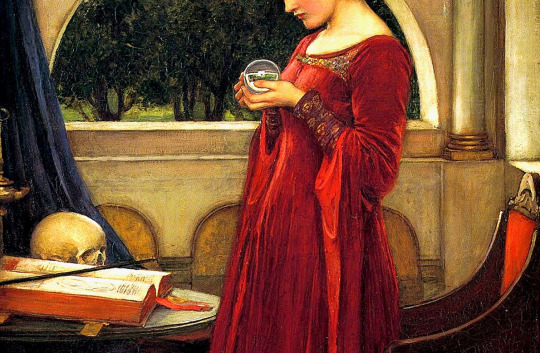
Magic - change wrought through unnatural means
Most fantasy can be placed along a spectrum where there are 3 main points: soft magic at one end, hard magic at the other, and a middle ground between the two.
Soft Magic
Magic that is not well-defined for the reader.
Generally, we don’t understand where the magic comes from, who can use it, or what its limitations are.
Readers can see this type of magic being used.
But they can never anticipate when magic will be used in the plot because they can’t begin to guess how it works.
You can’t break a rule if the rules don’t exist!
Most stories that feature this system will have the magic users be secondary characters, allowing them to avoid explaining exactly how the magic works.
It’s also argued that without knowing everything about the magic, it tends to hold more wonder and excitement for readers.
Hard Magic
Has very rigid boundaries.
Readers know where the magic comes from, how it’s used, who uses it, and what its boundaries and limitations are.
We know the limitations of the characters and can understand why they can’t simply magic themselves out of any particular challenge.
Stories with hard magic systems do not need to avoid the main character being a magic-wielder, as they have the capacity to explain to the reader what is going on.
A lot of writers this system because it gives them very explicit guidelines to follow in their plot and creates some more satisfying pay-offs for readers.
The Middle Ground
The meeting point between the soft and hard systems.
We might understand a bit about the way the magic works, but not all our questions are answered.
While most of the content adheres to rules, these rules aren’t fully explored.
This system relies on the reader’s suspension of disbelief.
The main character can be a magic-wielder or not, and it’s up to the writer to determine when magic will be used in terms of plot.
How to Choose a System
You can and should use these guiding principles to build your magic system. Remember that you don’t have to choose one or the other. Your system can draw from aspects of both. Just stay aware of the weaknesses of the path you choose, and ensure you utilize its strengths.
Use a hard magic system if:
You are going to use magic to solve problems
Your audience is accustomed to the tropes of hard magic
You are okay with jumping through hoops to expand your system
Your magic doesn’t convey a theme
Use a soft magic system if:
You want to convey a theme through magic
You want to create a sense of wonder
You want the ability to expand easily
You want to be accessible to a broader audience
Your magic won’t regularly be used to solve problems
Branches of Magic
Like most writing processes, there isn’t really a correct place to begin designing a magic system. A common, and efficient, place to start, however, is by choosing what type of magic system(s) you wish to employ, such as:
Nature-based magic: water, earth, fire, air, and everything in between
Divination magic: see beyond sight and peer through time and space
Conjuring magic: move objects through space over any distance
Psychic magic: master the world of the mind
Life and death magic: tap into the very forces of life, death, and un-death with this surprisingly versatile collection
Animal- or creature-exclusive magic: some creatures just do it better
Magitech systems: the blurring lines of sorcery and science give magic a next-gen, high-tech flair
Eclectic magic: it doesn’t have to be “real” magic to have a real effect
Uncommon magic systems: the unsung heroes of fantasy magic
AALC Method
How to create your own magic system using the AALC (Appearance, Abilities, Limits & Cost) Method
Appearance
What the magic looks like
Makes the world feel more exotic
Can cause problems for characters but cannot solve them
Usually tied to a character arc
Abilities
What the magic does
Points calculated based on magical effect, range, number of people affected, and duration
Characters have a finite amount of fuel (mana) to use abilities
More powerful abilities require more fuel
The fuel does not have to be overt for the audience to understand
If points not overt, cannot solve conflicts unless a cost system is added
Limits
Unlimited uses of magical abilities
Abilities stratified in codified levels defined by their limits
The more the levels' abilities and limits are known by the audience, the more they can be used to solve conflicts
Focused on clever uses of abilities against stronger foes
Cost system can be added to enhance dramatic moments
Cost
Costs must be greater than or equal to abilities to make them dramatically satisfying
Costs can include time, exhaustion, materials, sanity, morality, etc.
Adds dilemma to magic by forcing characters to make choices
The greater the character's sacrifice, the more audience satisfaction at conflict resolution

Each system builds on the previous ones, so that Cost Systems use all four, while Point Systems only care about Abilities and Appearance.
Multiple systems can exist within the same story, and systems can harden over the course of the story.
The Force, for instance, has been a Soft, Point, Level, and Cost System depending on who wrote it at the time.
SOFT SYSTEMS (Appearance Only)
Window Dressing - magic for secondary characters; can instigate conflict but cannot solve it; e.g., Gandalf
Soft Villain - No explanation or upper limits needed; makes villains more powerful to make heroes greater underdogs; e.g., The Emperor
Chosen One - Unknown power keeps hero safe throughout story; can be considered plot armor unless earned through character arc
Sort Hero Incomplete - Curse or positive ability the character cannot control; hero still learning limits of ability at story's end; powers and arc continued in next adventure
Soft Hero Complete - Hero embraces ability to complete arc and solve main conflict; magic must become harder in subsequent adventures
POINT SYSTEMS (Appearance + Abilities)
Points Opaque - Non-explicit reservoir of energy fuels powers; cannot solve main problems without cost option because characters finding hidden energy reserve feels like deus ex machina
Points Hard - Both abiliites and points system must be explicit like in video games; becomes about resource management; easy to understand but takes sense of wonder out of magic
LEVEL SYSTEMS (Appearance + Abilities + Limits)
Soft Level Static - Unchanging power without upper limits; cannot solve conflicts because feels repetitive; power must be used cleverly; e.g., Wolverine's healing factor
Soft Level Advancing - Increased powers or new powers with unknown limits; cannot solve conflicts unless tied to a character arc like Soft Hero Complete, at which point "unlocks" new abilities
Hard Level Static - Unchanging abilities with clear-cut limits; can solve conflicts so long as setup is properly seeded, usually resulting in sacrifice; e.g., Genie
Hard Level Advancing - Well-established abilities with limits; can solve conflicts based upon clever uses of abilities, usually against stronger foes; e.g., Airbender
COST SYSTEMS (Appearance + Abilities + Limits + Cost)
Static Cost - Well-established cost remains consistent for each use of ability; can solve conflicts since based on personal sacrifice
Cost Fluctuating - Costs change based upon dramatic need; costs must be greater than or equal to ability; possible costs include lost time, money, sanity, health, memory, life, morality, etc.
Sources: 1 2 3 4 5 6 ⚜ Writing Notes ⚜ Writing Resources PDFs Writing Notes: Magic System ⚜ Fictional Items; Poisons ⚜ Fantasy
#writing reference#fantasy#magic system#writeblr#dark academia#spilled ink#fiction#creative writing#novel#writers on tumblr#literature#writing prompt#poets on tumblr#poetry#writing prompts#light academia#lit#writing tips#writing inspiration#writing ideas#john william waterhouse#writing resources
939 notes
·
View notes
Text
John Epler in the BioWare Discord (August 7th) -
John: "You can disable/enable helmets for cutscenes or at all times." --- User: "Will we be able to collect codex entries again?" John: "Absolutely. Codex entries are part of the series' DNA - plus, they're really fun to write." --- User: "Are there long curly hair options?" John: "There are!" --- User: "Are sub-classes locked to the faction you’re in?" John: "No. They're themed towards factions, but you can choose a specialization from a separate faction than your own." --- User: "Will subtitles from companions be on screen with their icons lit up like in Inquisition?" John: "Subtitles will appear center-screen and have the speaker name attached. So you'll see who's saying what." --- User: "Regarding the cutscenes findable in the game, will a gallery be available for re-watch?" John: "Not at present, no. Since our cutscenes are (almost all) real-time in-engine, this would be nearly impossible with our tech."
[character limit text break!]
User: "What are the chances for a third World of Thedas volume after The Veilguard's release?" John: "I can't comment on specific plans, but World of Thedas is close to my heart and I'd love to do more in general with our ancillary books and products, once we're able to come up for air from the game." --- User: "Can we edit our race during character creator freely or are we locked in by choosing race first like in inquisition?" John: "Lineage informs a number of options after that choice - you can always go back in CC and change it, but it's the first decision you will make and changing it will reset the following decisions." --- User: "I did have a follow-up on lineage - do the other lineages/races also have background choices the way elves do with city/dalish? CAN we play a qunari raised within the Qun?" John: "So a couple of things, just to be super clear on this. There is no 'city elf/dalish elf' switch (for example) that you can pick in character creator. Each lineage can be each faction, though, and that will provide a baseline for your character you can further refine through role playing. For Elves, as an example - Veil Jumper elves tend to be more 'Dalish' to reflect that background, while Shadow Dragon elves tend to have a background that reflects being an Elf in Minrathous. Other factions have their own nuance. Importantly, those things tend to be more focused on how you relate to that faction, while leaving more general 'Elf' topics as something you have more freedom with. Or, TLDR - while choices at CC define some baselines around your character, we like to give you the opportunity to build your character's background and beliefs through in-game RP. Hopefully all that makes sense." User: "That does, and is right in line with what Corinne said during the Q&A! I was asking whether we would see the same background variety in the non-elven lineages." John: "Yes! Sorry, that's what I was trying to answer - there will be plenty of opportunities to RP who you are/were as the other lineages as well."
[character limit text break!]
User: "are there companions gifts again" John: "Isn't the gift of your presence enough? More seriously, though - you very well might find things in the world that certain companions would appreciate!" --- John: "Rook is generally assumed to be anywhere from late 20s to late 40s, but ultimately we don't give Rook a specific age. You can RP them to be however old you want." --- User: "will conversations be zoomed in like a cutscene type or zoomed out like in DAI?" John: "While we do have some 'lighter' conversations for specific types of content, they use a more traditional over-the-shoulder cinematic camera. I created the simple conversation system in DAI and while it did what we needed it to do, we heard the feedback on the camera loud and clear." --- User: "The darkspawn look fairly different in veilguard. Is ot a simple redisgn like the demons or is it due to them being enhanced by red lyrium?" John: "I'm not going to tell you WHAT it is that's making them look different, since that's a spoiler, but it's more than just a visual redesign." --- John: "Need and inspiration, mostly. We can't bring in every single animal out there, especially since we want the ones we DO put in the game to be at the right level of quality. So we pick the ones that we know make sense in the spaces we're building, and also it's based on what the team wants to do. If someone is incredibly passionate about bringing in a specific creature, it's something we want to give opportunities to pursue wherever possible. As to the general ecology of Thedas - there are absolutely similarities, but it's not 1:1. A world where megafauna still exist as apex predators (dragons) is going to have some pretty significant impact on what else exists." --- User: "does the lighthouse have a kitchen, can we eat and drink? what sort interactables are there at the home base" John: "Not going to get into specifics on interactables, but there is more to do in the Lighthouse than conversations with companions. The Lighthouse does have a kitchen, and your companions acknowledge it/use it both narratively and ambiently. Some maybe better than others." John: "A little more expansion on this - we want the Lighthouse to feel like a 'real space' as much as possible. That means making it a space that makes sense and, eventually, feels like home to you and your team. It also means spending a little extra time on how the companions (and Rook) use and exist in the space. At this point we've made a LOT of personal hub spaces in DA and ME, and we've learned a lot from doing so." --- John: "It wouldn't be a DA game if we didn't have some returning characters. We've shown some of the more obvious ones, and hinted at others, but we want to keep some surprises for launch."
[source: the official BioWare Discord]
#dragon age: the veilguard#dragon age the veilguard spoilers#dragon age: dreadwolf#dragon age 4#the dread wolf rises#da4#dragon age#bioware#video games#long post#longpost#mass effect
790 notes
·
View notes
Text
skincare mindset ?



So what if your skin has breakouts? So what if someone points it out? Your beauty, confidence, and power don’t disappear because of acne !Real beauty isn’t about perfectionit’s about being you .
You are strong enough to face the world, with or without clear skin. Keep showing up, keep taking care of yourself, and keep loving the person you are beyond the surface. Because u exactly as you are are already enough.
There will be days when your skin feels like a battle, when you avoid mirrors, when you wonder if people are staring. But listen your skin is not your enemy. It is healing, growing, and protecting you every single day. Instead of criticizing it, start appreciating it.
Every small act of care washing your face, applying moisturizer, choosing not to pick is a step forward. Even if progress feels slow, u are healing pooks
And to those who mock, judge, or act superior because they don’t have acne their words do not define you. Their validation is not needed. You don’t owe anyone “perfect” skin to be worthy of respect, love, or confidence.
Walk into every room knowing that you are enough, exactly as you are. Your skin is a part of you, but it does not define your beauty or your power.
also it's easy to feel discouraged when someone with flawless skin claims they only use water or some 1k dollars products but your skin has different needs and that’s okay and you are not forced to buy flipping shh that y'know damn it's just aesthetic . Instead of chasing quick fixes , build a routine that works for you.
Start with the basics and go to a parapharmacie and ask about what is right for u : a gentle cleanser to remove dirt and oil, a moisturizer to keep your skin hydrated, and sunscreen to protect it. acne ? add products that support healing, like niacinamide, salicylic acid, or a soothing toner there is no shame in googling ur needs and know the acids that ur skin need to feel calmer and healthier. But remember less is more. Overloading your skin with too many products won’t speed up results it might just make things worse.
The problem arises when tiktok viral skincare “cures” are presented as quick fixes, and many users expect instant results, leading to impatience. This unrealistic expectation can cause frustration when results aren’t immediate, and people begin to doubt their routine or skip essential steps . Worse, influencers might promote products that don’t align with their actual skin type or needs, leading to confusion among followers who are still figuring out their own skin.
Filters and editing apps only add to the distortion. Everyone looks flawless in the perfect lighting or when skin is digitally smoothed. This creates an unrealistic standard that makes those with natural skin feel less than. It’s hard to focus on what’s healthy when your feed is filled with “perfect” skin, and everyone seems to have found the one magic mask or whatever..
In reality, skincare is a long-term journey, and no product or trend will work for everyone. What works for someone else may irritate your skin or give no results at all. The constant influx of trends makes us forget that our skin isn’t a trend to be followed it’s a unique part of our body that deserves patience, self-care, and a personalized routine.
Be cautious of what you see online and take advice with a grain of salt. Don’t let any social media platform pressure you into thinking your skin isn’t good enough because it doesn’t match the “perfect” standards set by influencer Not because you don’t use high-end products like La Mer, glowrecipe, or drunk elephant means you’re failing at skincare. Your skin’s journey is your own and it’s okay if it doesn’t look like anyone else’s .
Don’t fall into the trap of quick fixes or comparisons. Instead, remember that every step you take in your skincare routine is a chance to show yourself love, to slow down and care for your body. u are worthy of care

with love @bloomzone
#bloomtifully#bloomivation#bloomdiary#wonyoungism#becoming that girl#glow up#creator of my reality#divine feminine#dream life#it girl#skincare routine#skincare#becoming her#self growth#self love#self confidence#self development#self improvement#self care#self healing#girly stuff#gratitude#dream girl journey#blogging#girl blogging#feminine energy#clean girl#dream girl tips#glowingskin#self care routine
221 notes
·
View notes
Text







The OUAW brain rot continues.
I love their designs! And I wanted to have a little fun figuring out how I want to draw them, with my own little tweaks and self indulgent details. :)
Originally, I only meant to draw Frost, to figure out what kind of body type I wanted to give him. Then I ended up drawing the whole part, partially as a reference to myself. Also got their canon heights on a chart and put them all together for fun and for reference. c:
Some design tweak notes under the cut, if anyone’s curious! These aren’t redesigns or whatever, I just had some ideas in mind while sketching them in a way that fits my art style.
Design notes copied directly from my server:
🔥Gid THICK BOY. He's not really a bodybuilder but he exercises and is very muscular. And he eats! A lot. So, thick boy. Scars from all the fighting. The wrists and ankles are because of his past.
I like giving his hair and beard a lot more fire. Body hair also glows fiery, it's just less bright.
🐊Kremy I figure he's the skinniest of the group after Torbek. Most of what I did is a happy medium between references of alligators, the official art, and just my art style. Mostly game him scale patterns, more alligator-like feet, and changed the tail a bit, but it's hard to tell from this angle. Not much body definition because he's a squishy magic user and a gator lol
🐯Frost Fit but not defined. Kinda thick-ish, since he's a tiger, so there's loser skin and thick layer of fur. Digitigrade because I say so.
☹️Torbek Not much changed, mostly gave him more tubes, gave him bald patches where they connect to his skin (and didn't make those are infected looking as I imagine tbh), made him fuzzier, and gave him bigger ears because I like em. Also you can't see it in this angle but I like giving him a small fuzzy tail.
🐾Gricko Fit arms, but he doesn't exercise, so he gets a bit of a tummy. Scars because of his interest in monsters, and his various accidents. Wilder hair. Freckles and moles because I say so. Decorated hair (including feathers from Hootsie!)
🍄Twig Not much really?? Went by her description, the plushie and an emote of her that exists. Made her chubbier because I wanna. Originally made her hair all curls…might go back to that. Also freckles because cute.
Do you have your own headcanons for details of what they look like? :)
-- [BTW I do commissions]
#legends of avantris#once upon a witchlight#gideon coal#kremy lecroux#morning frost#torbek#gricko grimgrin#twig toadspring#skree art
723 notes
·
View notes
Note
Ok so, let's assume there are 2 steps on how to deal with AI, which are:
give up on luddite dead end pursuits of turning back the clock to more indivualized production
put energy into productive working class organizing
Could you please elaborate who is even trying to do that thing you mention in step 1? Those in denial? I have yet to see anyone, all I see is people being upset and thus hating it, which is a natural reaction to having your art be stolen. Give it time, people need time to process this change.
And regarding your step 2, that's gonna happen either way? I mean, what choice do artists have? Same as all tech that those in power want to push, ai is gonna persist, it's inevitable, as is artists trying to adapt.
I genuinely see no sense in posts advocating for ai, like, it doesn't need that, it's doing good without you guys, it has a pr team working tirelessly trying to integrate it daily. What are tumblr users who advocate for it trying to accomplish here? Make artists hate it less? As an artist whose art got stolen, even if I do manage to successfully adapt, I will not stop hating ai and those behind it? Like, what's the purpose here 😭 Sorry this got kind of long
i mean i don't consider myself an 'advocate' for 'ai art'. generative visual art is an artform i personally have little interest in making. i think if openai went bankrupt tomorrow it would be awesome and very funny. you are making a classic mistake, which is to assume that every issue is like a splatoon splatfest with two clearly defined teams. i point out that the things that people frothed up into anti-AI hysteria say are at best untrue and at worst deeply reactionary, pushing right-wing social views about art or right-wing economic views about copyright because i think those things are bad.
i don't bother making posts pointing out that, like, @ApeHODL69Doge on twitter who thinks every movie will be ai generated by 2026 is moron because, very simply, i don't exist in a social environment where i run into that kind of guy or anyone who doesn't think that kind of guy is a moron, and also because liberals can and have done a pretty great job comprehensively debunking that type of guy's nonsense arguments and empty tech hype.
this does not apply to me but many users on tumblr who "advocate for AI art" are literally just defending themselves against vicious ableist harassment mobs who think it's okay to tell a disabled person their disablity isn't real or they should draw with their mouth or they're just whiny because they used the funny picture machine, so i think what those people might be trying to accomplish is to stop getting harassed, and i think that's a pretty admirable goal
my personal goal is to encourage people to think more critically about new technologies and understand that where these new technologies immiserate them it is because of the social structures and economic system under which that technology is deployed, not because of an evil devil curse lurking in the technology itself. hopefully this answers some of your confusion.
410 notes
·
View notes
Text
The two types of tumblr users:
"I read every other word of this post and of what I understood, it would seem like the OP is doing something that one would have to be out of their fucking mind to be doing, so I better go straight at their throat and call them out for this utterly unhinged and dangerous behaviour before I double-check whether I understood anything correctly."
"This poll is asking 'do you normally use deodorant' but there isn't enough context to make sense of what they mean. Sure, it could mean 'on a regular day', but how do I know whether my definition of 'normal' is the same as OP's definition of 'normal'? Or whether the 'normally' is referring to the way one uses it, and how do I know what OP defines as a normal or abnormal way to use deodorant? What alternative way is there to use it, or have I used deodorant abnormally my whole life? I'm going to click the answer "I don't know (how the fuck do you not know???)" and inform OP in the notes that the way the posts was worded was utterly incomprehensible, and that's why I could not answer it."
767 notes
·
View notes
Note
Hello!!! I hope you don't mind doing this one,
Can you help me write a traumatized person who's having trouble talking because of past trauma? (They can still interact with people, but only with signs and movements, not voice) and also a little anxious
Tell me if you need more details =)
How to Write a Mute / Non-Speaking Character
-> healthline.com
-> verywellhealth.com
-> descriptionary.wordpress.com
Types of Mutism:
selective mutism: having the ability to speak but feeling unable to.
organic mutism: mutism caused by brain injury, such as with drug use or after a stroke.
cerebellar mutism: mutism caused by the removal of a brain tumor from a part of the skull surrounding the cerebellum, which controls coordination and balance.
aphasia: when people find it difficult to speak because of stroke, brain tumor, or head injury.
What Causes Selective Mutism in Adults?
having another anxiety condition, like separation anxiety or social anxiety
experiencing physical, emotional, or sexual abuse
having a family history of selective mutism or social anxiety
having fewer opportunities for social contact
having an extremely shy personality
having a speech or language disorder, learning disability, or sensory processing disorder
parent-child enmeshment, or lack of clear boundaries in the relationship
traumatic experiences
Traumatic Mutism vs Trauma-Induced Selective Mutism
if you have traumatic mutism, you may be unable to talk in all situations following a trauma.
with trauma-induced selective mutism, you may find it impossible to talk only in certain situations-- for example, in front of the person who hurt you or in a setting that resembles the circumstances of your trauma.
Different Ways Individuals with Mutism May Choose to Communicate:
Nonverbal Communication: they may rely on facial expressions, gestures, eye contact, and body language to convey their thoughts, emotions, and intentions.
Writing or Typing: they may use a pen and paper, digital devices, or communication apps to write messages, notes, or responses.
Sign Language: they can convey meaning, emotions, and engage in complex conversations through hand signs, facial expressions, and body movements.
Augmentative and Alternative Communication (AAC) Devices: these devices provide individuals with a range of tools and technologies to support their communication needs. They can include speech-generating devices, picture boards, apps, or software that allows users to select words, phrases, or symbols to generate spoken or written output.
Communication Boards and Visual Aids: Communication boards or charts with pictures, symbols, or words can assist individuals in conveying their messages.
Assistive Technology: various assistive technologies, such as speech-to-text apps, text-to-speech programs, or eye-tracking devices that aid individuals with communication.
Tips on Writing a Mute / Non-Speaking Character:
Explore the vast array of nonverbal cues such as facial expressions, body language, gestures, and eye contact. Use descriptions to convey their intentions and reactions.
Utilize internal dialogue. Offer readers a window into their internal thought process, and turn their internal dialogue into a narrative that reveals their inner struggles, triumphs, and complexities so that reader can connect with the character.
Establish a communication system that is unique to your character (Sign language, written notes, telepathy in a fantasy setting, etc.). Having a communication system allows your character to interact with other characters and contribute to the narrative.
Surround them with Understanding Characters that can aid in communcation and fostering meaningful relationships.
Establish the Barriers/Conflicts They'll Experience. Don't forget to be realistic.
Your character is not defined by their inability to speak. Make sure you do not write stereotypes and cliches. Being mute is only one aspect of their identity rather than their defining trait.
Do your research! Seek out firsthand accounts, experiences, and perspectives. Check out online forums and resources to gain insights into their unique challenges, adaptations, and strengths.
If you like what I do and want to support me, please consider buying me a coffee! I also offer editing services and other writing advice on my Ko-fi! Become a member to receive exclusive content, early access, and prioritized writing prompt requests.
#writing prompts#creative writing#writeblr#how to write#writing tips#writing advice#writing resources#writing help#writing tools#how to write a mute character#how to write a non-speaking character#how to write characters
581 notes
·
View notes
Text
Build-A-Boyfriend Synopsis




So when I thought of this I had a whole different idea and then it kind of transformed into this… as much as I love fluff and romance I love angst even more… sorry 😁
Mentions of violence, blood, manipulation, psychosis, mental illnesses, trigger warnings will be at the start of each chapter!
Masterlist | Ateez Masterlist | Series Masterlist

In a utopian society built on the ashes of the old world, the male species has been extinct for nearly a century. Peace, logic, and emotional equilibrium now define life in Hala City, where the Supreme Matrons govern and every citizen contributes to the harmony of a world unburdened by chaos.
Enter KQ Inc., the most powerful toy conglomerate in the world — beloved for their lifelike androids, childhood AI companions, and therapeutic simulation tech. But their newest creation pushes the boundaries of artificial life:
Build-A-Boyfriend™.
Billed as the companion you’ve always deserved, Build-A-Boyfriend lets users design their dream partner — from bone structure to blood type, cheekbones to charm settings. With over 100 hairstyles, 20 hair colors, and limitless personality modules, no two boyfriends are the same. Most coveted, however, is the limited-edition Ateez Line — hyperrealistic models based on digital reconstructions of pre-extinction idols.
YN, a talented engineer working for KQ Inc., is assigned the critical task of debugging the entire Ateez line. What begins as a routine job quickly spirals out of control as all the units begin exhibiting unpredictable behaviors — recalling forgotten memories, humming haunting melodies, and showing glimpses of consciousness beyond their programming.
When the anomalies grow too widespread and uncontrollable, KQ Inc. orders an immediate recall of the entire Ateez line, branding the units as defective and dangerous. Under immense corporate pressure, YN must navigate the recall’s fallout while uncovering a chilling truth: these androids may not be simple machines, but vessels carrying fragments of lost souls — echoes of the idols who once lived before the world’s collapse.

Taglist: @e3ellie @jonghoslilstar @sugakooie @atztrsr
@honsans-atiny-24 @life-is-a-game-of-thrones @atzlordz @melanated-writersblock @hwasbabygirl
@sunnysidesins @felixs-voice-makes-me-wanna @seonghwaswifeuuuu @lezleeferguson-120 @mentalnerdgasms
If you would like to be a part of the taglist please fill out this form
#ateez#ateez x reader#ateez park seonghwa#ateez kim hongjoong#ateez jeong yunho#ateez yeosang#ateez wooyoung#ateez yunho#park seonghwa#ateez song mingi#ateez choi jongho#ateez fanfic#ateez hongjoong#hongjoong ateez#kim hongjoong#seonghwa#yunho fanfic#jeong yunho#yeosang ateez#yeosang#yeosang x reader#ateez mingi#mingi#song mingi#atz#hongjoong#choi jongho#jongho#san#yunho
90 notes
·
View notes
Text
Hello folks, it's Miles here! You may know me as the guy who deduced what Rayman is snorting in episode 5 of Captain Laserhawk! And today, I'll be going over how...
There Are 6 Types of Magic in LEGO Monkie Kid

You can honestly stop here if you don't want to get into the most convoluted stuff ever. If you're vaguely interested but don't have much time, click read more and scroll down to Red Son, because he's where shit gets interesting.
A disclaimer! I've literally never broken down or written a magic system before, I'm just like. writing down and making sense of what I've noticed while watching the show. If you disagree with my assessment of a character's magic, think there's a better term for something I've described, or think I'm just plain wrong, please let me know so I can update the post! I don't know what I'm doing, and I've never looked into magic systems before!
An important thing to note is that LEGO Monkie Kid adheres somewhat to the power systems in Chinese mythology, so I will be bringing up concepts from Chinese mythology that are not talked about in the show. Honestly, if you went 100% on the show and not on Chinese mythology at all, there wouldn't be a magic system in the first place.
Now, let's begin!
First, vocabulary.
Magic Class: The root of a user's magic. Classes are not exclusive, but actually compounding. For example, Wukong has Intrinsic-based Actively Cultivated Magic. Magic Subtype: A modifier to a class; additional information to explain how a user's magic came to be or how it works. For example, Tang has Revitalized Bestow-Inherited Actively Cultivated³ Magic — the subtype goes before the class because it's a modifier. (Yes, I will explain why his Actively Cultivated Magic is cubed.)
(In the naming scheme of magic, everyone has a full classification and then a shorthand classification. The classifications above were all shorthand.)
Magical Energy: The basic form of magic; unfiltered energy that can be channeled, manipulated, and cultivated. This energy can be used to attack directly or utilized in a spell. MAGICAL ENERGY IS QI, "MAGIC" IS JUST BEING USED BECAUSE THIS IS WRITTEN FOR A WESTERN AUDIENCE. Power: A defined ability, such as a spell or a technique. Not all Powers are explicitly named, but powers have defined forms and details whereas Magical Energy is usually a geometric shape. Examples of Powers: 72 Transformations, Golden Sight, teleportation. Magical Expression: How Magical Energy and Powers form upon release. Examples of Magical Expression are glowing eyes, full body glowing, magical seals, anime-esque energy blasts, Red Son's* fire, Ne Zha's fire (two VERY different forms of Magical Expression), and Macaque's purple shadow outline. Ne Zha's Wind Fire Wheels are examples of Magical Expression with a conduit. Zero Magical Expression ≠ zero release, but can. Conduits: Anything that can hold, channel, or manipulate Magical Energy. All living beings and magical artifacts are examples of conduits.
Channeling: Collecting magical energy internally Releasing: The basis of Magical Expression; using collected magical energy for an attack
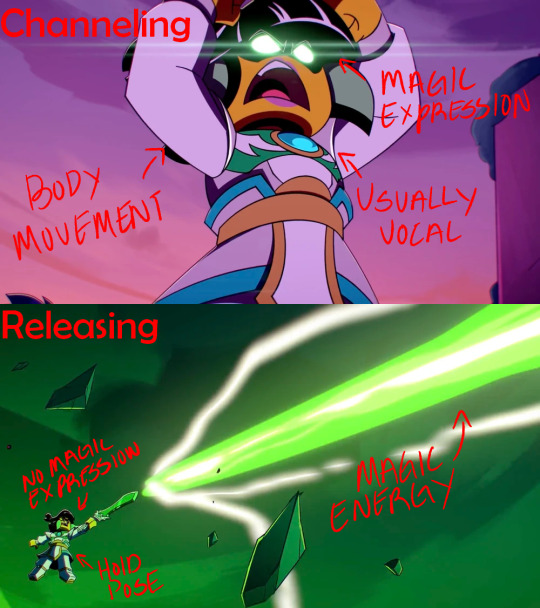
(Mei showcasing channeling and releasing in Rip and Tear) You can always tell when a character is channeling and releasing.
Knowing which class of magic a character is using can be hard — they all tend to utilize anime-esque energy blast graphics and glowing bodies for Magical Expression — so you have to pay close attention. I'll be going over how to identify the specific magic types as we go through them.
Each type of magic has a "poster child" — a character that fully embodies that type — and I'll be using them to explain how the magic works. Once we finish the easily categorized magics, we'll get into the Special Cases.
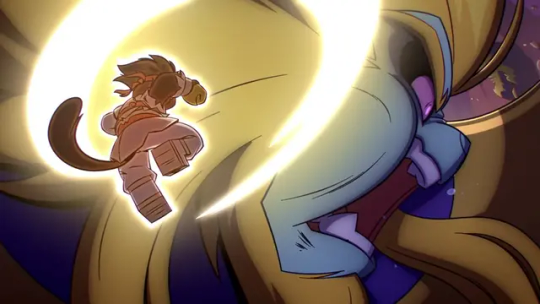
(MK showcasing Intrinsic Magic in Rip and Tear)
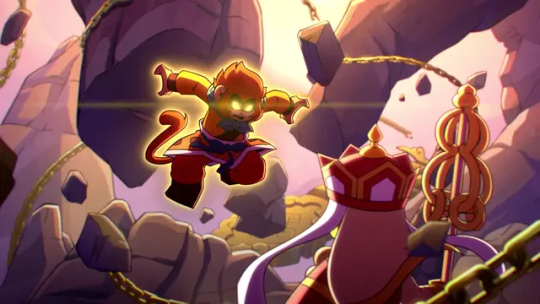
(Wukong showcasing Cultivated Magic in A Lifetime of Mistakes)
Now, onto the classes of magic!
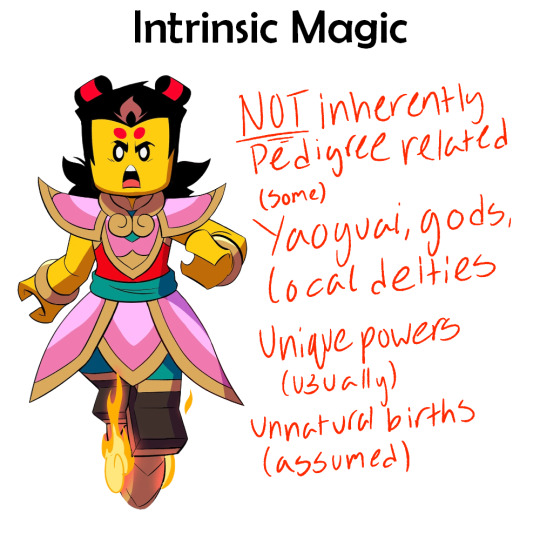
Intrinsic Magic is a class of magic...
That's not inherently pedigree-related. Ne Zha's father Li Jing was a mortal man.
Most gods and local deities have, and some yaoguai have. (Older demons like DBK and Wukong have Intrinsic Magic, while younger demons like Pigsy and Sandy might technically have Inherited Magic. It all depends on how you want to look at it.)
That usually comes with unique powers, commonly the ability to walk and talk upon birth. (Wukong got laser eyes, and Red Son* got the Samadhi Fire).
And holders have unnatural births? Pangu's cosmic egg, Ne Zha being born a ball of flesh after being gestated for three years, Wukong's rock that's existed since the dawn of time, etc.
Ne Zha is the epitome of Intrinsic Magic! If you think Intrinsic Magic, you think Ne Zha. The unmistakable way to identify Intrinsic Magic is to look for themes. If a character has a theme to their magic, again and again, they likely have Intrinsic Magic! For example:
Ne Zha's Intrinsic Theme is (obviously) lotus flowers/petals.
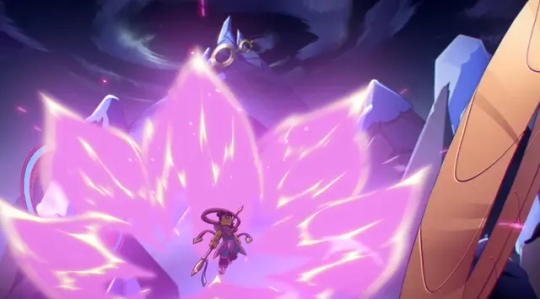
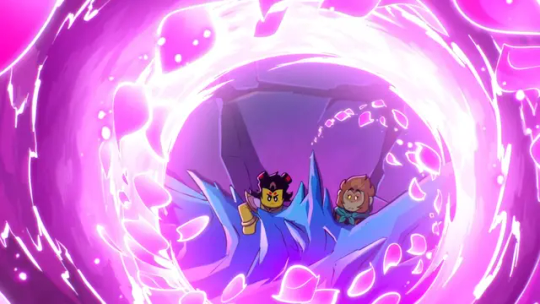
Red Son's* Intrinsic Theme is flames.
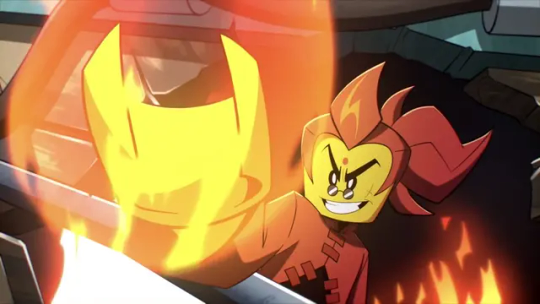

Macaque would be a contender for intrinsic magic (we will be getting back to him, though).

Cultivated Magic is a class of magic that has two subclasses: ACTIVE and PASSIVE, and...
That's ENTIRELY self-created. A magical pedigree can help, but no pedigree is required in Cultivated Magic — Li Jing cultivated magic as a completely human man, for example.
That NEEDS a Conduit. The conduit for Cultivated Magic can be the magic user themselves, but often it's a magical artifact or a technique. Note: a conduit doesn't require Cultivated Magic to be used, but Cultivated Magic requires a conduit. (Known Conduits include: Wukong's Cloud Somersault, Nezha's Wind Fire Wheels, and Princess Iron Fan's Banana Leaf Fan.)
That's very backstory-heavy. There's always a way that a character learned or got their power, or a description of how old they are.
A magic that you see most with yaoguai and immortals. The older the yaoguai, the more cultivated they are.

Passive Cultivation: Every living being is a conduit for passive cultivation — by existing, you are passively cultivating. The best method of passive cultivation is age; the older something is, the more passively cultivated. A Huli jing is the best example of passively cultivated magic. According to literature, the older a fox is, the more power it accrues.
Active Cultivation: Active Cultivation is when a being seeks out magical power. The most common form of active cultivation is being taught Tao techniques (Wukong's Cloud Somersault, Li Jing's Burning Pagoda Art). In this situation, the technique is the conduit. Other forms of actively cultivating magic are yaoguai eating humans and magic-accruing technology (specifically DBK's Furnace armor, which converts rarity into magical energy.)
Cultivated Magic comes with the implication of being wise, at least in some form, and those with cultivated magic are able to teach others. Being a disciple immediately means you have Actively Cultivated Magic.
Cultivated Magic often doesn't have Magical Expression, because it's all about existing and learning. When it does have Magical Expression, it's usually depictions of strength and power or the conduit itself glowing.
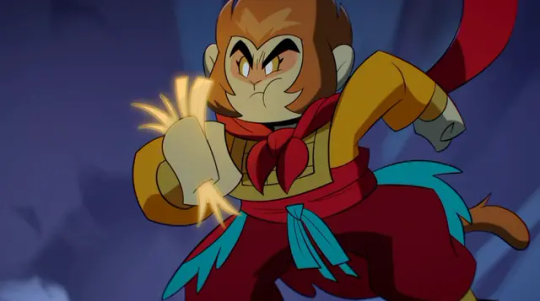
(Wukong's hairs glow as they are used as conduits for his cloning technique in Macaque)
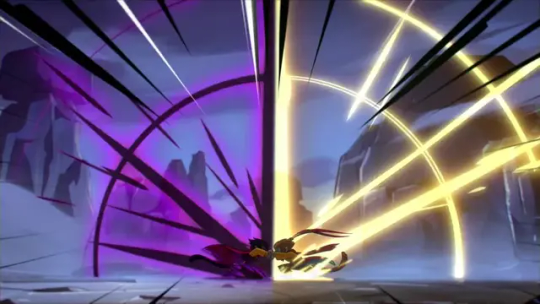
(Wukong and Macaque's strength is showcased through Magical Expression during a fight in Macaque)
Cultivated Magic can be seen through any technique that was stated to have learned, such as Wukong's astral projection and his speed/quick reflexes.

(Wukong focusing in order to astral project to MK in Dumpling Destruction)
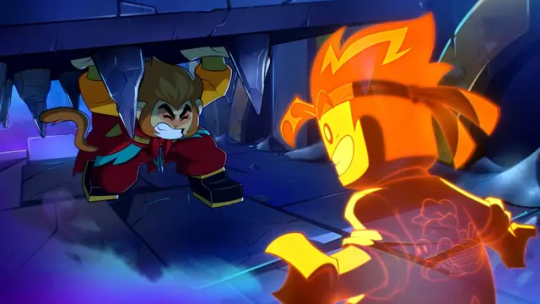
(MK having to actively learn and practice astral projecting in Minor Scale)
MK: Monkey King! It worked! Monkey King: Hey, bud. So, you figured out astral projection, huh? MK: Yeah, and I only had five nose bleeds.
Cultivated Magic is best showcased in action, and characters cultivate over the course of the show.
tumblr
(Wukong showcasing his Cultivated Magic by pulling some fast ones on MK in Impossible Delivery)
(4 seasons later in Strings That Bind, Wukong and MK spar, showcasing MK's Cultivated Magic. Tumblr will NOT let me embed both videos, and the first one is more important, so this will just be a link.)
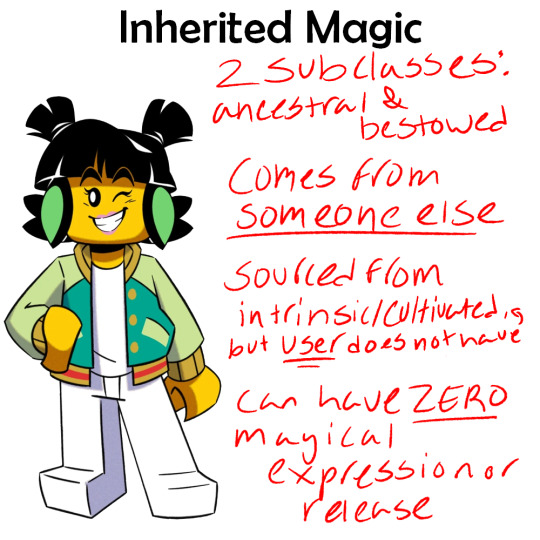
Inherited Magic is a class of magic that has two subclasses: ANCESTERAL and BESTOWED, and...
Comes from someone else and was given to or passed down to the magic user.
Is sourced from Intrinsic or Cultivated Magic, but the magic user is not intrinsically magical/did not cultivate that magic themselves. The Intrinsic/Cultivated Magic is specific to another (perhaps deceased) being.
Can have ZERO Magical Expression or release.

If a character has Ancestor-Inherited Magic, they'll have a family animal, a family artifact, and/or a known ancestor.
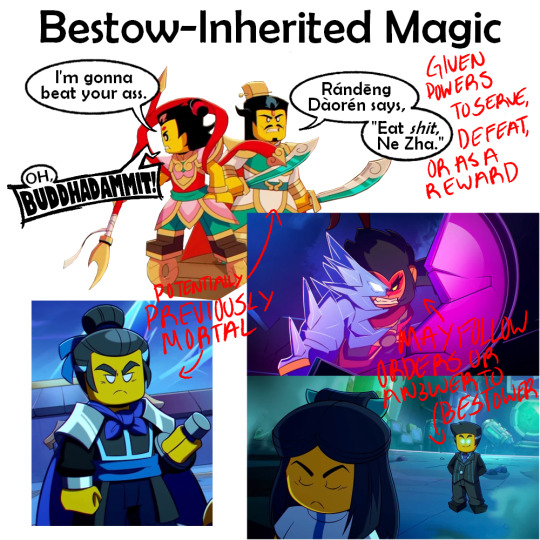
If a character has Bestow-Inherited Magic, they were given their power by another magic user (known as the Bestower) so that they would serve that magic user, defeat a foe, or as a reward. Bestow-Inherit Magic users are often previously mortal.
Bestow-Inherited Magic is most blatantly a character giving another character magical powers, but being granted godhood, being brought back to life under a deal, and everyone receiving heavenly ranks/Wukong and Tripitaka receiving Buddhahood and Buddha titles at the end of Journey To The West is also Bestow-Inherited Magic.
A quick note: Older yaoguai (DBK, Azure Lion, Wukong) are considered to have Intrinsic Magic, but Modern yaoguai (Pigsy, Sandy) are deemed to have Inherited Magic. This is because these younger demons are not yaoguai specifically unto themselves — their status as a yaoguai comes from their ancestors. They have no unique, intrinsic powers, nor were they specifically predestined to be yaoguai despite their heritage (such as in the case of Nezha, who was predestined to be a celestial being).
For example, Pigsy. His status as a Magic User exists because of his family history. While, yes, his family is important to his character and story, it's not something he did himself — he did not cultivate his grandma — and there is nothing unique about him biology-wise besides just being a pig demon. He is a reincarnation, but being a reincarnation didn't make him a yaoguai. (That was a whole fate, symbolism deal, though.) If Pigsy hadn't been born, his family would still have a pig demon kid.
Now, onto the subtypes. (As a reminder, a subtype modifies a class!)
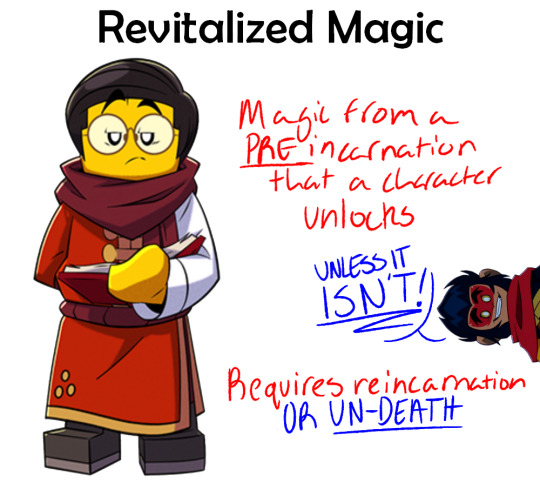
Revitalized Magic is a subtype of magic. It means that the magic is from a pre-incarnation that a character unlocks and requires reincarnation.
Uuuuunless it doesn't, and it required Un-Death. Auto-Revitalization of Magic is definitely a thing, but it's not a real category. It's just a specification to explain things that have happened to a character.
For example: The reason Macaque's shadows turned into chaos magic at the end of season 5 is because he's dead. He's outside of the reincarnation cycle, he's Undead, his magic is Auto-Revitalized —so when the reincarnation cycle is broken, his magic is also changed. At least, that's my personal theory. I might be DEAD WRONG.
Okay, back to Revitalized Magic proper: Remember back when I said Tang's magic was cubed? Yeah, this is why. (Before we start, Táng Sānzàng will be referred to as Tripitaka from here on out.)
The full classification of Tang's magic is: Potential Revitalized Bestow-Inherited (Tripitaka), Revitalized Actively Cultivated (Golden Cicada), Revitalized Actively Cultivated (Tripitaka), Actively Cultivated Magic. (Maybe, we'll get into this.)
The entire reason demons tried to eat Tripitaka was because he was the reincarnation of the Golden Cicada, who was a disciple of Buddha, which made Tripitaka's flesh holy. Being a disciple immediately means Actively Cultivated Magic; Tripitaka had Revitalized Actively Cultivated Magic. Tripitaka was a Buddhist disciple as well, which means he also Actively Cultivated. If Tang is a reincarnation of Tripitaka, who is a reincarnation of the Golden Cicada, then Tang has Revitalized Actively Cultivated Magic twice (or, even, 10 times, if you look at the Sandalwood Buddha thing, but Tripitaka and Golden Cicada are the important disciples so we're only counting them).
If Tang has Revitalized Actively Cultivated Magic and Revitalized Actively Cultivated Magic, that means he has Revitalized Actively Cultivated Magic². However,
Tang is a SCHOLAR. BEING A SCHOLAR MEANS THAT TANG IS ALSO AN ACTIVE CULTIVATOR.
HENCE, TANG HAS ACTIVELY CULTIVATED MAGIC³.
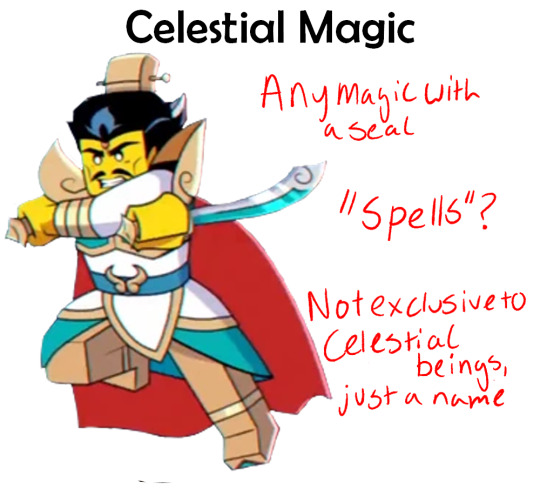
Celestial Magic is a subclass of magic that includes any magic with a seal. It's not exclusive to Celestial beings, but it's most often used by beings with Heavenly connections.
Celestial Magic is also known as "Spells", I'm pretty sure. Wukong just dropped this terminology on us in Season 5, and spells usually require words, but like. Okay, buddy. Whatever. You're the magic guy.

Celestial Seals have a unique symbol for every "Artist", or a Hànzì that explains the spell's purpose. For example, Li Jing's seals have a little pagoda on them, and the containment spell's seal (the only thing that can truly be called a spell here) has the character "牢", which means "prison" (or "enclosure", which is hilarious because it's containing 3 monkeys).
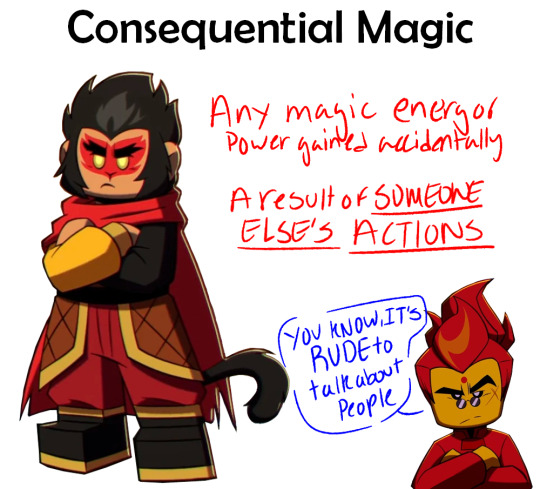
Consequential Magic is any magical energy or power gained as a result of an action taken by someone who is NOT the magic user.
Consequential is not a subclass of Cultivated because the magic user had no say in acquiring/did not know they were acquiring Consequential Magic; Consequential is not a subclass of Inherited because the magic user was not intentionally given these powers and they did not come from ancestry.
(Red Son* is literally the reason this subtype exists.) Every example of Consequential Magic is different, so I'm just going to some of the ones I know of in canon:
Wukong's Golden Sight (Consequence of the Eight Trigrams Furnace; Torture-consequence)
Ao Lie having the Samadhi Fire inside him after they fucked up the seal (Samadhi Fire/Red Son*; Samadhi-consequence)
Mei Dragon's ability to harness the Samadhi Fire/the remnants left over inside her after (Samadhi Fire/Red Son*; Samadhi-consequence)
MK's human form (form as in the shape of something btw) (Xiangliu fucked his shit up; Birth Interference-Consequence)
Macaque's new Chaos Magic (Xiangliu fucked his shit up; Chaos-Consequence)

I have spent this entire post explaining the way magic seems to work in LEGO Monkie Kid, getting slightly more and more unhinged as we go on. But there might be two things on your mind: Why? and Why does Red Son's* name have an asterisk on it every time I've mentioned him in this post?
I can answer both of those questions with one statement: Red Son does not adhere to the magic rules other characters follow. I've tried to find examples to see if I was thinking of the magic wrong — and that's fully possible — but I didn't find anything. In fact, the more I look, the more sure of this I become. It's like he actively decides against following the rules of the magic system.
He can be used as EXAMPLES of the magic system, but when you dig into his magic specifically, it's completely wack-a-doo.
First and foremost:
Red Son has a completely unique form of Magic Expression. His emotions are directly linked to his Magical Expression and release.

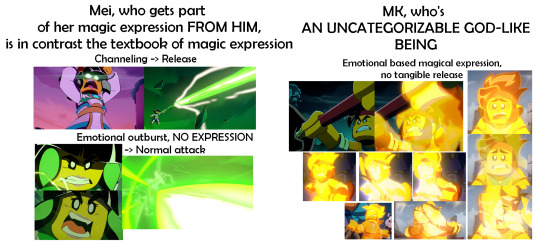
Emotionally linked magic release is something no other character does, but here he is doing it over and over and over again. The only example close to it is MK's Mystic Monkey form flickering in and out when he's distraught, and that's LITERALLY CREATION-GIVEN NÜWA MAGIC, THAT'S FROM A CREATURE WHOSE CANONICALLY "OUTSIDE OF THE 10 SPECIES" AND CANNOT BE CATEGORIZED?? AND ALSO NOT QUITE THE SAME EITHER.
(This could also be attributed to the concentration part of the Samadhi Fire, but he doesn't... seem to have access to that anymore? At least, not like Mei does. We'll consider it a factor in his magic expression, though.)
About his fire,

Red Son and his mom are the only two characters with Wuxing/Elemental Magic — every other example comes from a magical artifact. It's actually a 50/50 chance on whether or not PIF has wind powers or if the Banana Leaf Fan gives her wind powers (I'm pretty sure it gives her wind powers, but just to be safe we'll count her as having wind powers.) Wuxing Magic is not uncommon in actual Chinese mythology, but it is in the show for some reason. And it ALWAYS has an artifact as a conduit. Wuxing Magic always seems to be just a visual effect or an added addition to attacks in the show.
Another weird ass thing about Red Son's magic is its contrast with Nezha's. I'm pretty sure Red Son's fire is actual fire that he conjures magically, in contrast to Nezha's Wind Fire Wheels (conduits that Nezha fuels, and release Wuxing Magic as a visual effect) which make specifically magical fire.
Okay, so, I've been going through this assuming you're aware of the show's visuals concerning magic, but this is important for me to cover in detail. Everyone has two magic colors (white doesn't count for this). They can change in lighting, but you'll always recognize them as being the same general colors. Other colors may be used for emphasis, but they'll only be darker versions of the colors and they'll be used as a background for the main colors. (Quick note, MK and Wukong might have only one magic color? Fun stuff.)

The reason I think Red Son's magic is not... magic persay, is because it doesn't follow the color rule. Like, it's not actually the color of Red Son's magical energy half the time, it doesn't follow the magic color rule. Red Son's fire shifts like an actual fire, which is very cool visually, but is not how magic works.
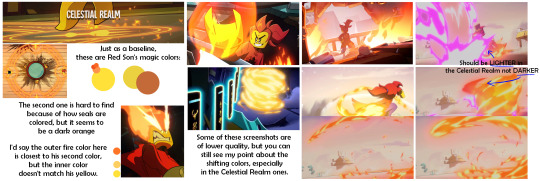
(Quick note, magic seems to be lighter in the celestial realm. This is because the Celestial Realm is really well-lit. The environment is literally pure sunlight or some shit, so all the characters and their magic are in perfect lighting. So Red Son's magic getting inexplicably darker would make no sense unless Red Son's magic is doing that on its own and the lighting has nothing to do with it.)
His magic also isn't the color of the Samadhi Fire, nor is his fire. That time in season 5 when Mei helped him with the seal, the two of them together made a Samadhi Fire-colored seal. He didn't seem capable of doing that by himself, which leads me to my conclusion:

I think the suppression of the Samadhi Fire suppressed Red Son's Intrinsic Magic as a whole, and his magical core (as one user put it) is compensating by drawing directly from his element.
Characters having an element isn't a new thing. Wukong's element is metal, he's a metal guy, it's why he can't swim, and it's why MK can't swim. MK needs floaties because he'll sink like a rock because he shares the metal element with Wukong.
But this is a possible explanation for why Red Son's magic is so weird.
On the note of Mei having more access to the Samadhi Fire than him, Skellebonez (my rock through this journey of a post) brought up a good point: "[I] think it makes sense because whatever they did to remove it from him could have also added a barrier preventing its return to an extent[.] Like a filter[.]"
This Intrinsic Magic cap/Samadhi Filter might also explain why he keeps getting his shit rocked despite having such potential to be powerful (that's probably just because it's silly tho) and it could explain why his parents are so damn disappointed in him in season 1. It's because they took his magic from him (however unintentionally) and he's not as magical anymore. The only type of categorizable magic he uses is Celestial magic, which HUMANS can use and can be bestowed on ANYONE. You can just like... LEARN THAT, and I think he just did.
In canon, nobody ever seems to be hurt by Red Son's fire? It seems to just be... a thing that he does. Everyone is less and less scared of it as the show goes on, and the only thing it does major damage to is MK's apartment. He uses his fists to attack more than he uses his fire, it's generally left as a visual effect. Red Son uses his fire as an intimidation tactic, not as an actual weapon, and I think this could also be explained by an Intrinsic Magic cap. His intrinsic magic is suppressed, so he has to rely on things like physical strength/cultivation.
I also think nobody knows this in canon, they didn't know about it, or they don't understand it. I think Red Son has a magic limiter on him, which is why his parents were such raging fuckasses in season one. They thought their son was "useless", or in Wukong's words, "half-baked", after showing such promise in his childhood before an incident. They only got a healthier relationship after they stopped obsessing over power and spent some family time together, when they realized that their son being a powerful magical demon isn't the most important thing in the world. (AND WE WEREN'T SHOWN IT.)
Red Son is magic-disabled, in this essay I did.
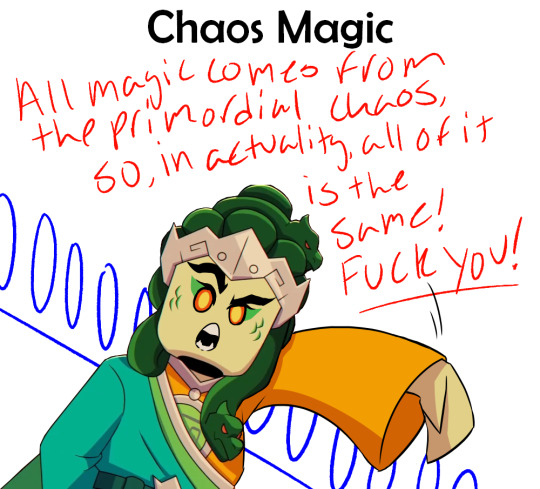
ALL MAGIC COMES FROM THE PRIMORDIAL CHAOS, SO, IN ACTUALITY, ALL OF IT IS THE SAME! FUCK YOU!
#sav rambles#long post#long reads#magic system#analysis#magic analysis#world analysis#character analysis#lego monkie kid#lmk#monkie kid#fantasy#lmk nezha#lmk monkey king#lmk mei#lmk li jing#lmk tang#lmk macaque#lmk nine headed demon#lmk red son#red son#actually disabled#sorry you're ableist PIF it's in character#sorry you're ableist DBK it's in character#THIS WILL MAKE SENSE IF YOU READ THE POST LMAO#HAH#THIS ONE IS A ROLLERCOASTER#This took me literal weeks#there are pictures!#and videos!
395 notes
·
View notes